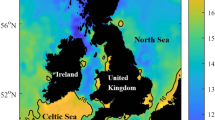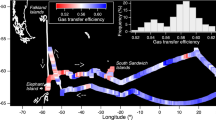Abstract
Convective vertical mixing in restricted areas of the subpolar oceans, such as the Greenland Sea, is thought to be the process responsible for forming much of the dense water of the ocean interior1,2. Deep-water formation varies substantially on annual and decadal timescales3,4,5, and responds to regional climate signals such as the North Atlantic Oscillation6,7; its variations may therefore give early warning of changes in the thermohaline circulation that may accompany climate change8. Here we report direct measurements of vertical mixing, by convection and by turbulence, from a sulphur hexafluoride tracer-release experiment in the central Greenland Sea gyre. In summer, we found rapid turbulent vertical mixing of about 1.1 cm2 s-1. In the following late winter, part of the water column was mixed more vigorously by convection, indicated by the rising and vertical redistribution of the tracer patch in the centre of the gyre. At the same time, mixing outside the gyre centre was only slightly greater than in summer. The results suggest that about 10% of the water in the gyre centre was vertically transported in convective plumes, which reached from the surface to, at their deepest, 1,200–1,400 m. Convection was limited to a very restricted area, however, and smaller volumes of water were transported to depth than previously estimated9. Our results imply that it may be the rapid year-round turbulent mixing, rather than convection, that dominates vertical mixing in the region as a whole.
This is a preview of subscription content, access via your institution
Access options
Subscribe to this journal
Receive 51 print issues and online access
$199.00 per year
only $3.90 per issue
Buy this article
- Purchase on Springer Link
- Instant access to full article PDF
Prices may be subject to local taxes which are calculated during checkout



Similar content being viewed by others
References
Killworth,P. D. Deep convection in the world ocean. Rev. Geophys. Space Phys. 21, 1–21 (1983).
Rudels,B. The thermohaline circulation of the Arctic Ocean and the Greenland Sea. Phil. Trans. R. Soc. Lond. A352, 287– 299 (1995).
Mosby,H. Deep Water in the Norwegian Sea. Geofis. Publ.21(3), 1–62 (1959).
Schlosser,P., Bönisch,G., Rhein,M. & Bayer,R. Reduction of deep-water formation in the Greenland Sea during the 1980s—evidence from tracer data. Science251, 1054– 1056 (1991).
Meincke,J., Jonsson,J. & Swift,J. H. Variability of convective conditions in the Greenland Sea. Int. Council Explorat. Seas Mar. Sci. Symp.195 , 32–39 (1992).
Dickson,R., Lazier,J., Meincke,J., Rhines,P. & Swift,J. Long term co-ordinated changes in the convective activity of the North Atlantic. Prog. Oceanogr.38, 241– 295 (1996).
Delworth,T. L., Manabe,S. & Stouffer, R. J. Multidecadal climate variability in the Greenland Sea and surrounding regions: A coupled model simulation. Geophys. Res. Lett.24, 257–260 ( 1997).
Manabe,S. & Stouffer,R. J. Century-scale effects of increased atmospheric CO2 on the ocean–atmosphere system. Nature364, 215–218 ( 1993).
Rhein,M. Convection in the Greenland Sea, 1982–1993. J. Geophys. Res. 101, 18183–18192 (1988).
Watson,A. J. & Ledwell,J. R. Purposefully released tracers. Phil. Trans. R. Soc. Lond. A325, 189– 200 (1988).
Ledwell,J. R. & Watson,A. J. The Santa-Monica Basin tracer experiment—a study of diapycnal and isopycnic mixing. J. Geophys. Res. 96, 8695–8718 (1991).
Ledwell,J. R., Watson,A. J. & Law,C. S. Evidence for slow mixing across the pycnocline from an open-ocean tracer-release experiment. Nature364 , 701–703 (1993).
Killworth,P. D. On “chimney” formations in the ocean. J. Phys. Oceangr. 9, 531–554 ( 1979).
Ivey,G. N., Taylor,J. R. & Coates, M. J. Convectively driven mixed-layer growth in a rotating, stratified fluid. Deep Sea Res. I42, 331 –349 (1995).
Visbeck,M., Fischer,J. & Schott,F. Preconditioning the Greenland Sea for deep convection—ice formation and ice drift. J. Geophys. Res.100, 18489–18502 (1995).
Law,C. S., Watson,A. J. & Liddicoat, M. I. Automated vacuum analysis of sulfur-hexafluoride in seawater—derivation of the atmospheric trend (1970–1993) and potential as a transient tracer. Mar. Chem.48, 57–69 (1994).
Ledwell,J. R., Watson,A. J. & Law,C. S. Mixing of a tracer in the pycnocline. J. Geophys. Res.103, 21499–22529 (1998).
Bönisch,G., Blindheim,J., Bullister,J. L., Schlosser,P. & Wallace,D. W. R. Long-term trends of temperature, salinity, density, and transient tracers in the central Greenland Sea. J. Geophys. Res.102, 18553–18571 (1997).
Mauritzen,C. Production of dense overflow waters feeding the North-Atlantic across the Greenland-Scotland Ridge. 1. Evidence for a revised circulation scheme. Deep Sea Res. I43, 769–806 (1996).
Aagaard,K., Fahrbach,E., Meincke,J. & Swift,J. H. Saline outflow from the Arctic-Ocean—its contribution to the deep waters of the Greenland, Norwegian, and Iceland Seas. J. Geophys. Res.96, 20433–20441 (1991).
Bevington,P. R. & Robinson,K. Data Reduction and Error Analysis for the Physical Sciences (McGraw-Hill, New York, 1992).
Klinger,B. A., Marshall,J. & Send,U. Representation of convective plumes by vertical adjustment. J. Geophys. Res.101, 18175– 18182 (1996).
Send,U. & Marshall,J. Integral effects of deep convection. J. Phys. Oceangr.25, 855– 872 (1995).
Acknowledgements
We thank the staff of RV Håkon Mosby, RV Johann Hjort and RRS James Clark Ross for their support, and B. Guest, S. C. Sutherland, M. I. Liddicoat, R. D. Ling and T. Fileman for assistance. The main support for this work was from the EU MAST-III programme, European sub-polar ocean project, phase 2. Additional support from the following national agencies was also important: NERC (UK) NRC (Norway) and NSF (USA).
Author information
Authors and Affiliations
Corresponding author
Supplementary information
Averaging of property profiles along potential density surfaces
In reducing the data from the surveys of the Greenland Sea we used the procedure of averaging properties along surfaces of constant potential density. This corrects for vertical displacements due to internal waves or eddies which cause isopycnals to have a significant but temporary slope. Figure 1, shows the four average tracer profiles for the surveys discussed in the paper, where the ordinate is potential density reduced to a 500dB surface (s0.5). However, in order to derive "conventional" coefficients of turbulent exchange, which are expressed in units of diffusivity (length2 time-1) it is necessary to render the resulting average profiles back into units of depth. We adopted the procedure described by Ledwell and Watson (1991), in which average pressure-vs-density profiles from the surveys were employed to transform the density ordinate back into depth. Figure 2 shows the four potential density-vs-depth profiles used for these transformations.
The resulting average profiles of tracer are slightly less spread with depth if isopycnal averaging is used than if straightforward isobaric averaging was used. The isopycnal procedure allows us to plot the tracer results of one survey with the depth-vs-density curves of another, in order to investigate how much of the change in shape of the tracer profile with time is due to diapycnal mixing, and how much is due to the evolving depth-density structure. The SF6-vs-potential density curves of Figure 1 show that the tracer did not depart greatly from the density at which it was released during periods and regions not subject to convection (i.e survey 1, 2, and 3 outside the central gyre). The peak of the curve remains centered close to the density of release, though this density sinks in the water column with time. In contrast, the peak concentration of the tracer in the gyre centre moves to higher densities in response to convection. However, it also rises substantially in the water column, as figure 2 of the paper shows. The whole water column in this region becomes noticeably more dense and less stratified as a result of the convection, and the release isopycnal is displaced substantially towards the surface.
41586_1999_BF44807_MOESM1_ESM.gif
Supplementary Figure 1: Averaged SF6 tracer versus potential density (s0.5) for the surveys and regions described in the paper (GIF 18 kb)
41586_1999_BF44807_MOESM2_ESM.gif
Supplementary Figure 2: The average potential density versus depth curves obtained by averaging the same profiles as in figure 1 (GIF 18 kb)
Rights and permissions
About this article
Cite this article
Watson, A., Messias, MJ., Fogelqvist, E. et al. Mixing and convection in the Greenland Sea from a tracer-release experiment . Nature 401, 902–904 (1999). https://doi.org/10.1038/44807
Received:
Accepted:
Issue Date:
DOI: https://doi.org/10.1038/44807
This article is cited by
-
Numerical simulations of Atlantic meridional overturning circulation (AMOC) from OMIP experiments and its sensitivity to surface forcing
Journal of Oceanology and Limnology (2024)
-
The role of an interactive Greenland ice sheet in the coupled climate-ice sheet model EC-Earth-PISM
Climate Dynamics (2022)
-
High geothermal heat flux in close proximity to the Northeast Greenland Ice Stream
Scientific Reports (2018)
-
Long-lived vortices as a mode of deep ventilation in the Greenland Sea
Nature (2002)
Comments
By submitting a comment you agree to abide by our Terms and Community Guidelines. If you find something abusive or that does not comply with our terms or guidelines please flag it as inappropriate.



